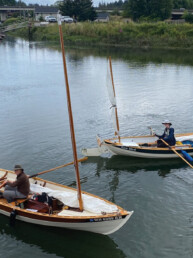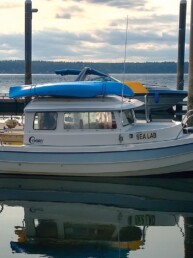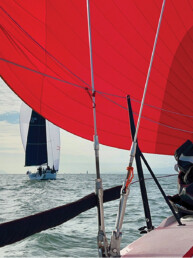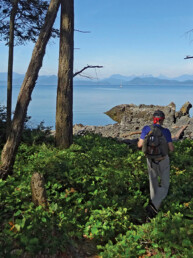The accomplished double-handed crew aboard J/111 Raku shares their story of Southern Straits,. They were the overall winners on the medium course.
After a two-year hiatus, one of the Salish Sea’s classic overnight distance races, Southern Straits, was back in action for 2022. Even better, travel requirements eased between the U.S. and Canada, and that meant a fleet of American boats could make their way to West Vancouver Yacht Club for some competitive racing over Easter weekend.
The forecast for race day didn’t look too inviting with rain, maybe snow, hours of no breeze, and cold temperatures. Ah, never trust a forecast! Yes, it rained a little, but it was also blowing 20 knots from astern at the same time, so we hardly noticed. There was a wind hole, but it was sunny, and didn’t last that long. Then, the forecast totally missed the big full moon and clear skies that made the night sailing just magical. Okay, there was snow just a few hundred feet up the mountains on both sides of the race course, but come on, how beautiful was that?
For many boats aspiring to a Hawaii race this summer (Vic-Maui, Pacific Cup), Southern Straits is used as a distance qualifier and a crew/equipment/watch test for a longer race. Its reputation is worthy of the hardy Canadians who created the race more than 50 years ago, and there have been years where the breeze was nearly hurricane force (but without the tropical temperatures!). It’s always a race to watch and respect.
Onboard Raku, our J/111, Chris and I had decided to tackle the 98 mile medium course doublehanded. We had considered racing the 145 mile long course with two of our J/111 sister ships, but the traditionally bigger fleet on the medium course appealed more to our competitive side.
Aided by a 2 knot push across the start line, it was a quick exit from English Bay with most boats starting out with kites. Many boats ended up switching to genoas to hold the course under Bowen Island. We made the unpleasant call to do a bareheaded change from our big A2 to a much smaller A3. We still barely held on — passing Bowen Island, we wondered if we should be more worried about water under the keel or our rig in the trees! We were much closer to the hard stuff than we would have preferred; but on the bright side, we have been working on dousing upwind without bearing off, and we’ve spent a lot of time recently working on keeping the boat on the edge when reaching.
Once past Bowen Island, we were able to ease sheets just as the breeze picked up to over 20 knots. Boats with kites still up were fully launched across the Strait of Georgia towards the first mark of the course at Sisters Islets, 50 nautical miles away to the northwest. Making fast tracks west turned out to pay big dividends as the wind proceeded to die off from the east. Only a few of the medium course boats stayed in the breeze, while most of the fleet had a midday timeout. We rounded the Sisters at a very civil 5 p.m. about 2 miles ahead of Jack Rabbit (CM1200) and proceeded to beat back home in 5 to 7 knots.

The breeze was a bit concerning, as we looked to be sailing into a parking lot near the Ballenas Islands. Then the promised northwesterly arrived 5 hours early just as we reached the edge of the hole. We got the kites back up quickly right around sunset, Jack Rabbit and Raku were only a boat-length apart making good progress on a very flat sea with a full moon shining through the kites. We spent about 30 minutes together before a little more breeze allowed us to sail slightly lower and achieve some separation to enjoy a rather pleasant night sail back across the Strait.
Let it be known the finish of Southern Straits at the Point Atkinson lighthouse is notoriously fickle (and likely cursed). First, you have to sail under Bowen Island, and then cross Howe Sound. Both places can offer up unpredictable wind holes. We succeeded in finding our wind hole under Bowen along with Jack Rabbit. Four miles from the finish, we lost steerage and were pointed 180 degrees from the finish line when the breeze filled back in. Jack Rabbit headed off to the southeast and Raku, once we turned around, headed off to the northeast. And then, a minute later, it was blowing 20 knots in Howe Sound! As we bore off to the south and scrambled to furl our Code 0, Jack Rabbit aimed right at the finish line. By the time we’d sorted ourselves out and started to beat towards the finish line, we could see Jack Rabbit right by the lighthouse. Had they already finished and were they just waiting to see the time delta to us?
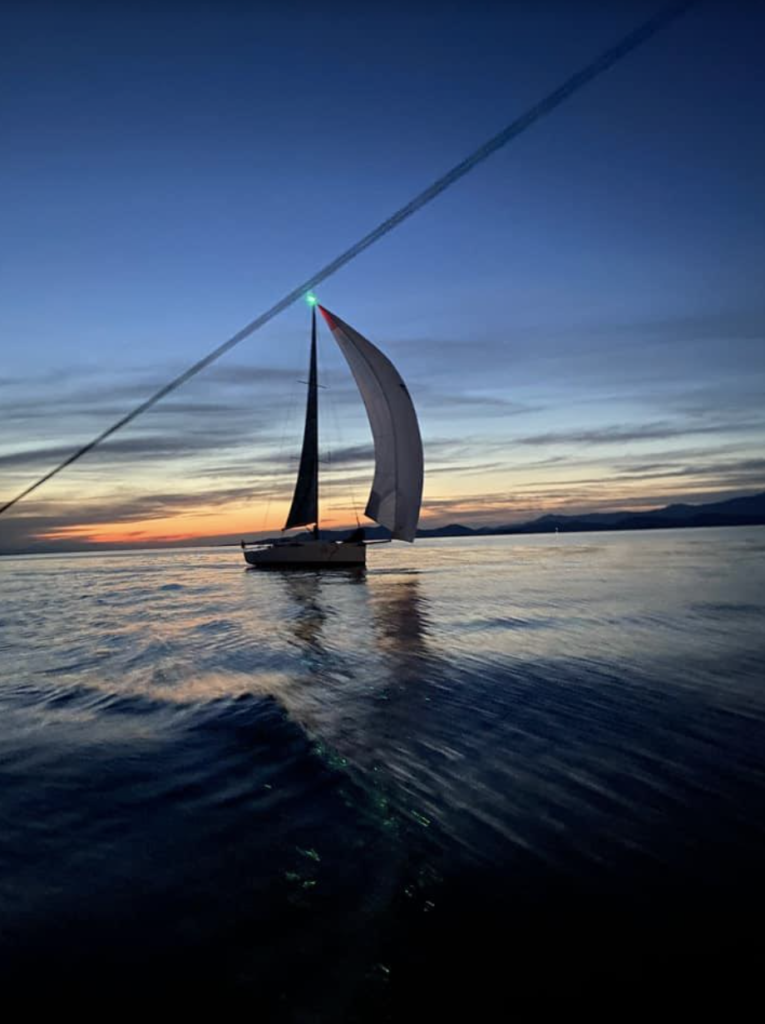
Our race hopes took a nosedive as we were now only going 2 knots with the wind coming directly from the finish. As we approached the finish in the dark, getting closer to Jack Rabbit, we could finally see they still had their genoa up, and they were pointed towards the finish. Hope was restored! Sure enough, the VHF confirmed Jack Rabbit’s finish, and then we ghosted across the line just a few minutes later at a surprisingly early 3:30 a.m. This finish drama seemed to repeat ad nauseum for many, many boats later in the race, too — it seems to be a hallmark of the race. Lucky for us, it was a happy ending, as we ended up first overall corrected on the medium course.
Title background photo of a J/111 sister-ship to Raku, 65 Red Roses II, who took second overall on the long course. Photo by Graeme Clendenan.

